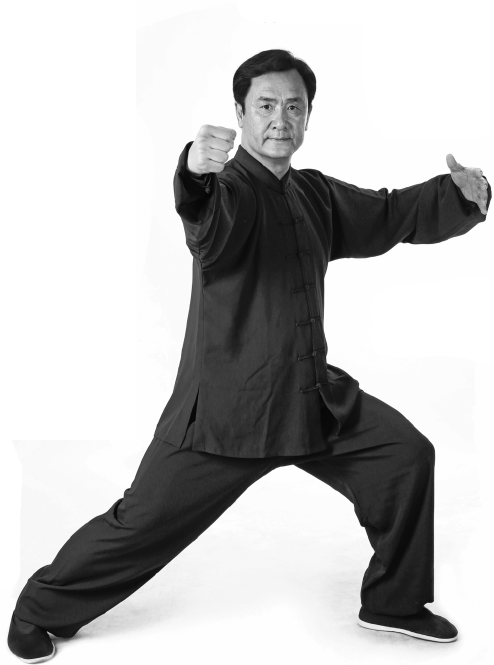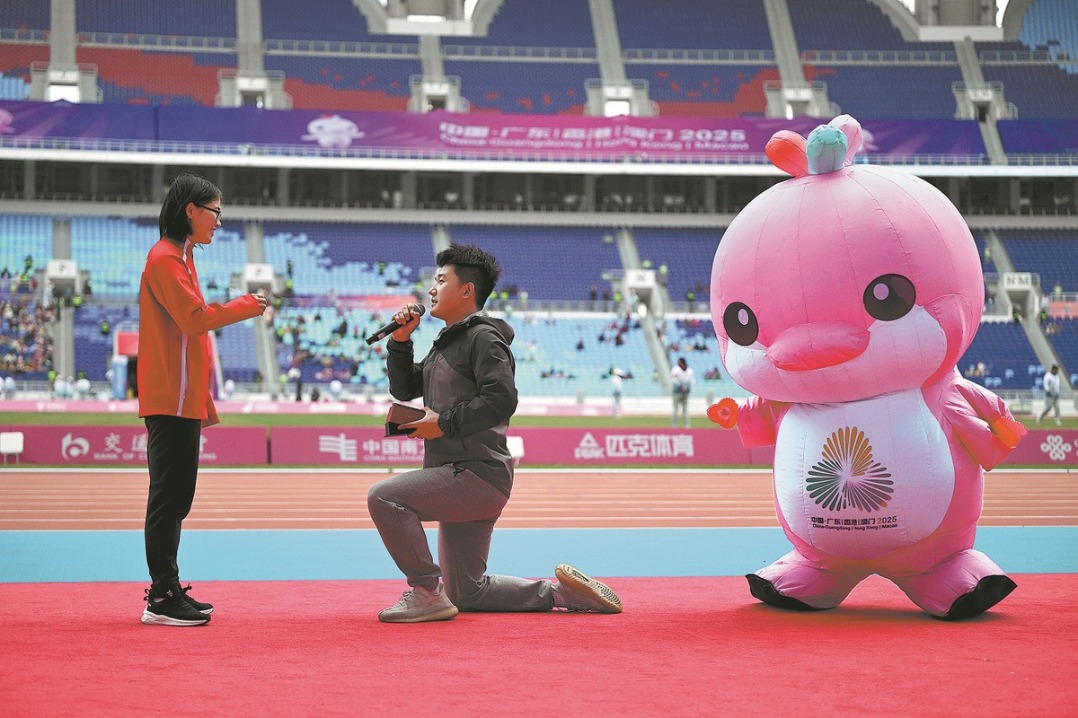The flow of knowledge
As an inheritor of multiple tai chi styles, Li Jianfang views it as his duty to pass on the traditions, techniques and profound culture of the martial art to future generations, Li Yingxue reports.

Whether it's under the moonlight, in a humble shelter, on lofty plateaus, or by the seashore, Li Jianfang has persistently practiced tai chi for decades with unwavering commitment.
He often reflects, "I may not remember a specific day when I practiced tai chi over these many years, but I certainly remember the days when I didn't."
Li, 66, a retired official, is the third-generation inheritor of Wang Qihe-style tai chi — a national intangible cultural heritage. He has been dedicated to practicing and spreading the martial art for over five decades. As well as teaching his students, he has been invited to various institutions and universities to give tai chi lectures and presentations.
"It is essential to preserve and pass down the correct traditional techniques, and it is crucial to identify and cultivate young enthusiasts of tai chi, nurturing their passion," Li says.
Wang Qihe (1889-1936), from Xingtai, Hebei province, dedicated himself to practicing multiple styles of martial arts, acquiring a wealth of skills and knowledge, later forming his own style of tai chi.
Wang Qihe-style tai chi includes two simplified routines with 13 and 24 forms respectively, two traditional routines with 84 and 108 forms and a dynamic, 38-form, fast-paced routine, as well as dedicated routines for saber, spear and sword.
For three generations of Wang Qihe-style tai chi inheritors, the transmission of knowledge and techniques has been conducted through one-on-one, hands-on instruction.
"This deliberate approach may have resulted in a slower dissemination, but it has effectively preserved the authenticity of the traditional methods in their purest form," Li says.
After decades of practice, Li thinks Wang Qihe-style tai chi is characterized by an authentic lineage, a systematic boxing theory, a moderate movement range and exquisite pugilistic techniques.
Li explains that in this style of tai chi boxing, the upper body is gracefully extended, exhibiting a harmonious balance between relaxation and tension, the techniques are precise and the lower body supplies great strength, maintaining stability while remaining agile.
"It encompasses various functions such as fitness, self-defense and personal cultivation," he says.
"In terms of technique, it emphasizes many subtle and refined aspects, including body posture, footwork, hand position, leg work, sharp vision, tactical strategies and, of course, spiritual cultivation. Every aspect is intricately interwoven with the precise and detailed principles of martial arts," Li adds.
Li was born in Ren county (now Renze district), in Xingtai, where Wang Qihe-style tai chi originated. He recalls that, in his hometown, many people practiced martial arts and they performed their skills on the street during festivals.
Liu Renhai, who was the senior disciple of Wang, was a popular figure at that time. At the age of 13, Li started to learn tai chi from Liu.
"At that time, I was just fascinated by the skills displayed by tai chi practitioners. Moreover, I had the opportunity to receive personal guidance from Liu Renhai himself. So, I dedicated myself wholeheartedly to learning the art, and became deeply engrossed in its practice. Since then, I have never stopped my training," Li says.
For over a decade, Li studied tai chi from Liu, who taught martial arts with unwavering patience and attention to detail. Whenever Li went to train, Liu showed no sign of impatience and Liu's wife would prepare meals for them.
Li recalls that just days before he passed away, at the age of 79, Liu could still push Li several meters effortlessly when teaching him tai chi.
"These experiences, day by day, subtly and gradually shaped me. Learning from him wasn't just about martial arts; it was about learning to be a better person," Li says.
Li has also learned from Wang Rongtang, Yao Jizu and Fu Zhongwen, all martial art masters.
As he improved his own tai chi skills, he gradually acquired his own students. His classes are made up of people from all walks of life, from grassroots workers to university professors, government officials, entrepreneurs and professional martial arts coaches. Regardless of profession, he holds them all in the same regard.
He primarily selects students based on two criteria: good character and genuine passion. "Finding a good teacher is challenging for students, but for a teacher, finding good students is even more difficult — it depends on fate," Li says.
Yang Wenyuan, 55, began practicing tai chi in 2010 with the aim of enhancing his overall well-being and physical fitness, in order to mitigate a demanding work schedule that was adversely affecting his health.
He started to learn Wang Qihe-style tai chi from Li in 2017 and, ever since, each year he will spend some time with Li to further his learning. He has also taken on his own students.
According to Yang, Li's proteges are spread across the country, but with the establishment of a WeChat group, communication has become more convenient.
"We share our training videos with the master, and he provides us with dedicated and detailed feedback. Other students also benefit from the master's insightful comments, and the entire group encourages each other, creating a positive and conducive learning environment," he says.
Li notes that tai chi is an aerobic exercise, known for its relaxed, stable, slow and even movements. The guiding principle is to shape the body with the mind, seeking a harmonious balance between the internal and the external.
He says that the benefits of tai chi include strengthening muscles and bones, cultivating internal strength, maintaining the health of internal organs, encouraging blood flow, regulating and nurturing energy flow, and cultivating wisdom.
Once, Li visited the shores of Nam Co Lake in the Tibet autonomous region, located at an altitude of 5,000 meters. He began to experience symptoms of altitude sickness due to oxygen deprivation. However, by practicing tai chi there, he says he was able to alleviate the symptoms and overcome it.
"This remarkable experience further reinforced my unwavering belief in the miraculous effects of tai chi, which involves directing energy flow with the mind and harmonizing the body's meridians," he says.
In addition to tai chi, Li has other hobbies such as calligraphy and poetry, and he believes that all forms of culture are interconnected.
"While different cultures may have unique expressions, they share a common foundation in conveying the universality of human nature. This allows for the blending and integration of diverse disciplines," Li says.
He thinks tai chi is a profound and encompassing art, representing a broad spectrum of traditional cultural nourishment. "Incorporating the influence of tai chi culture can be highly beneficial, regardless of one's profession or artistic pursuits. Conversely, the practice of tai chi requires the enrichment of various cultural influences," he says.
For many years, Li has been passionate about calligraphy. He thinks that, similar to tai chi, calligraphy follows the principles of balance, harmony and coordinated movement.
Li has also composed 46 poems in the form of ancient-style seven-character verse, encapsulating the movements of the traditional routines in Wang Qihe-style tai chi. His concise and refined poetry format has attracted the interest of learners, researchers and poetry enthusiasts to the art of tai chi.
During his decadeslong career as a government official, he used his spare time to practice tai chi at home and in the workplace. It was only after his retirement in 2020 that he wholeheartedly devoted himself to the widespread dissemination of tai chi.
He was not alone. Li and his wife, Tan Xingmin, were neighbors in the same village, and they had both been practicing Wang Qihe-style tai chi since a young age. In recent years, this devoted couple has been actively engaged in promoting the martial art and striving to enhance its popularity. Tan is now the president of Hebei's Wang Qihe-style tai chi association.
Wang Qihe-style tai chi was inscribed on the national intangible cultural heritage list in November 2014.
In 2020, the art of tai chi was officially inscribed onto UNESCO's Representative List of the Intangible Cultural Heritage of Humanity. As an inheritor of three different tai chi styles — Yang-style, Wu-style and Wang Qihe-style — Li, along with his wife, actively participated in the application process and played a crucial role in organizing and preparing the necessary documentation, including written materials, images, and video recordings.
He thinks the development of tai chi is a holistic undertaking that requires support from the government, guidance from public opinion, research from academia, standardization within the industry, self-discipline among different schools of martial arts, and the commitment of its successors, all working in synergy.
"As inheritors of tai chi, we must shoulder our responsibilities, elevate our capabilities, and play our part effectively," he says.



Today's Top News
- UN envoy calls on Japan to retract Taiwan comments
- Innovation to give edge in frontier sectors
- Sanctions on Japan's former senior official announced
- Xi stresses importance of raising minors' moral standards
- Coordinated reform key to country's growth
- Shandong gives new life to traditions






























